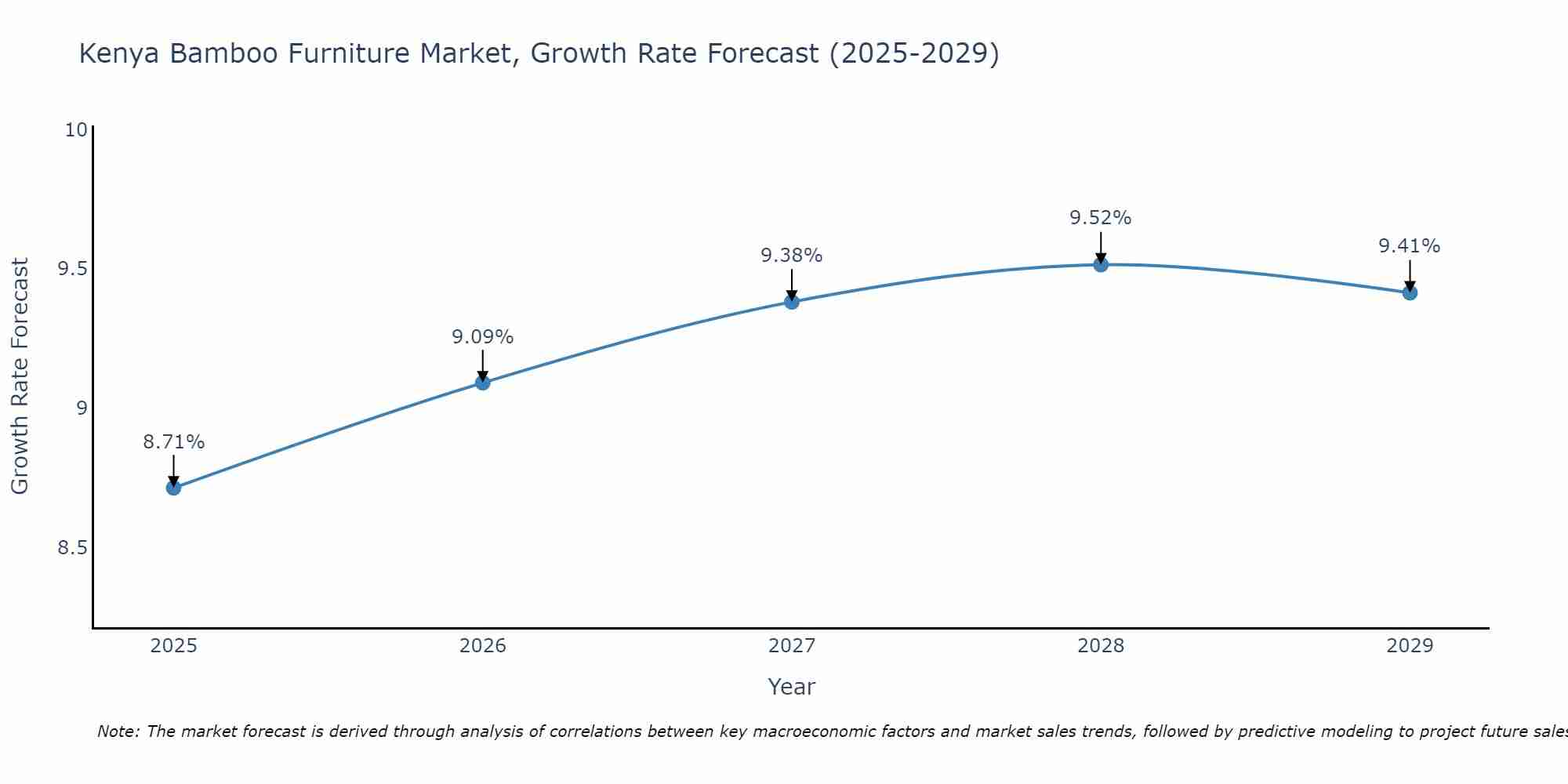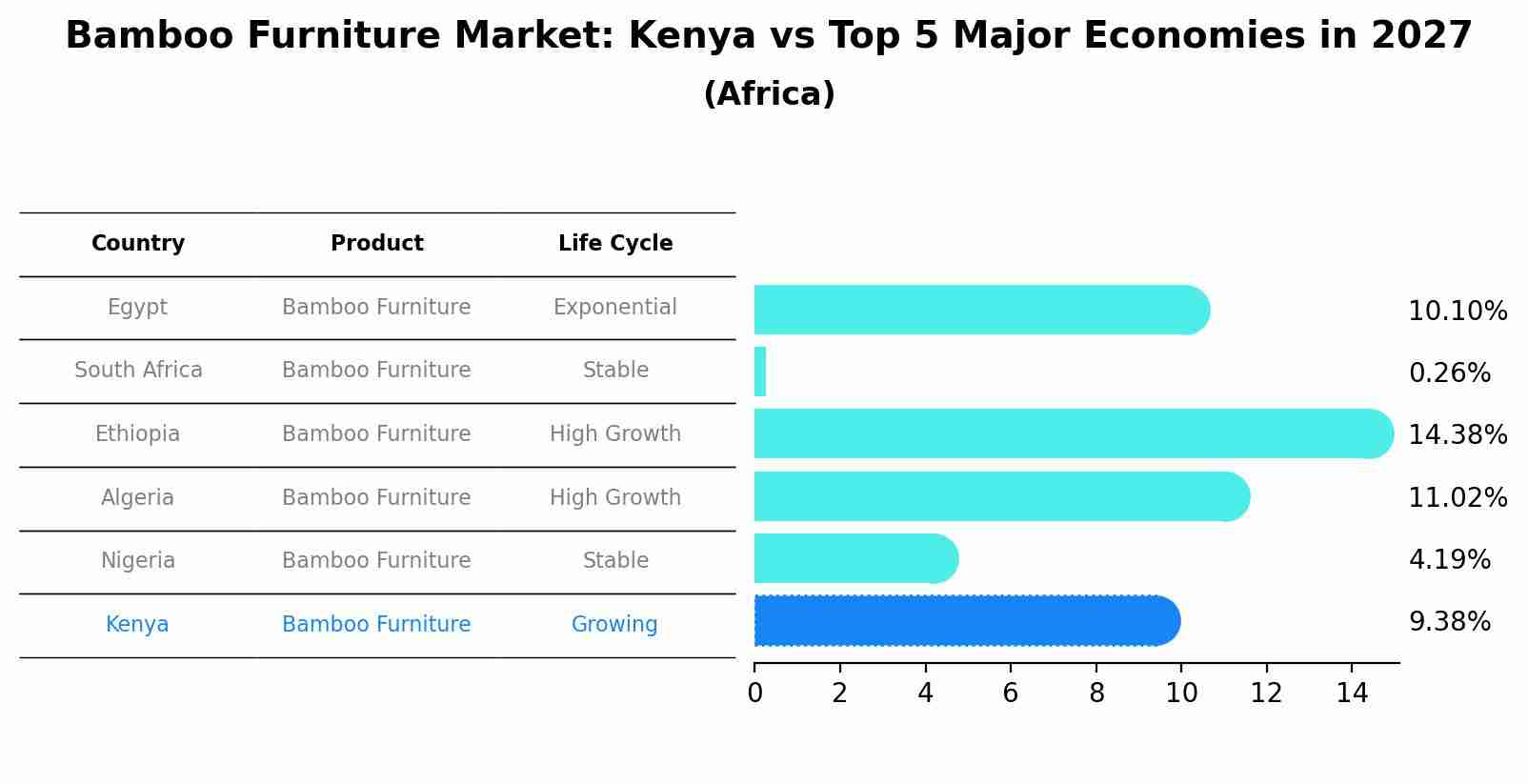Kenya Bamboo Furniture Market (2025-2031) Outlook | Industry, Growth, Size, Revenue, Share, Analysis, Trends, Companies, Value & Forecast
| Product Code: ETC370910 | Publication Date: Aug 2022 | Updated Date: Jul 2025 | Product Type: Market Research Report | |
| Publisher: 6Wresearch | Author: Summon Dutta | No. of Pages: 75 | No. of Figures: 35 | No. of Tables: 20 |
Kenya Bamboo Furniture Market Size Growth Rate
The Kenya Bamboo Furniture Market is projected to witness mixed growth rate patterns during 2025 to 2029. Growth accelerates to 9.52% in 2028, following an initial rate of 8.71%, before easing to 9.41% at the end of the period.

Bamboo Furniture Market: Kenya vs Top 5 Major Economies in 2027 (Africa)
The Bamboo Furniture market in Kenya is projected to grow at a growing growth rate of 9.38% by 2027, highlighting the country's increasing focus on advanced technologies within the Africa region, where Egypt holds the dominant position, followed closely by South Africa, Ethiopia, Algeria and Nigeria, shaping overall regional demand.

Kenya Bamboo Furniture Market Synopsis
The Kenya bamboo furniture market is experiencing significant growth due to the rising awareness of sustainable and eco-friendly products among consumers. Bamboo furniture is prized for its durability, natural aesthetics, and minimal environmental impact. The market is driven by the increasing demand for unique and stylish furniture pieces that also align with sustainability goals. Local artisans and manufacturers are capitalizing on this trend by producing a wide range of bamboo furniture items, including tables, chairs, and shelves. Additionally, the government`s initiatives to promote bamboo cultivation and value-added products are further boosting the market. As a result, the Kenya bamboo furniture market presents lucrative opportunities for businesses looking to cater to the growing demand for sustainable and stylish home furnishings.
Kenya Bamboo Furniture Market Trends
The Kenya Bamboo Furniture Market is experiencing a surge in demand due to the growing popularity of sustainable and eco-friendly products. Consumers are increasingly seeking furniture made from bamboo due to its durability, versatility, and environmentally friendly properties. The market is also witnessing a rise in innovative designs and styles incorporating bamboo, appealing to a broader range of customers. Local artisans and manufacturers are expanding their product offerings to meet the increasing demand for bamboo furniture, driving competition and pushing for more affordable pricing options. Additionally, the government`s initiatives to promote sustainable practices and support local industries are further boosting the growth of the Kenya Bamboo Furniture Market.
Kenya Bamboo Furniture Market Challenges
In the Kenya Bamboo Furniture Market, some of the challenges include limited awareness and understanding of bamboo as a sustainable and durable material for furniture among consumers. Additionally, there is a lack of skilled artisans and manufacturers specializing in bamboo furniture production, leading to limited design options and quality control issues. Infrastructure and logistical challenges in sourcing raw materials and distributing finished products also pose obstacles for businesses in the market. Furthermore, price competitiveness with traditional furniture materials and the need for continuous marketing efforts to promote the benefits of bamboo furniture further complicate the market landscape. Overcoming these challenges will require investments in education, training, infrastructure development, and marketing strategies to drive growth and adoption of bamboo furniture in Kenya.
Kenya Bamboo Furniture Market Investment Opportunities
The Kenya Bamboo Furniture Market presents promising investment opportunities due to the growing demand for sustainable and eco-friendly furniture options. Bamboo is a fast-growing and renewable resource that is becoming increasingly popular in the furniture industry for its durability, versatility, and aesthetic appeal. Investing in bamboo furniture production or retail in Kenya can capitalize on the trend towards environmentally conscious consumer choices. Additionally, the government`s focus on promoting sustainable practices and the potential for export opportunities can further boost the market`s growth potential. With the right market positioning and quality products, investors in the Kenya Bamboo Furniture Market can tap into a niche segment with high growth prospects and contribute to the country`s sustainable development goals.
Jordan Agar Market Government Policies
The Kenyan government has implemented various policies to support the growth of the Bamboo Furniture Market in the country. These policies include the National Bamboo Policy, which aims to promote sustainable bamboo utilization and value addition. Additionally, the government has provided financial support and incentives to bamboo furniture manufacturers through programs such as the Youth Enterprise Development Fund and the Women Enterprise Fund. Furthermore, there are efforts to enhance skills development in the industry through training programs and capacity building initiatives. Overall, the government`s policies are geared towards fostering the growth of the bamboo furniture market in Kenya by creating a conducive environment for investment, innovation, and sustainable development.
Kenya Bamboo Furniture Market Future Outlook
The Kenya Bamboo Furniture Market shows promising growth prospects in the coming years due to increasing consumer awareness of sustainable and eco-friendly products. Bamboo furniture is gaining popularity for its durability, versatility, and stylish designs, appealing to both environmentally conscious consumers and interior design enthusiasts. The government`s initiatives to promote bamboo cultivation and the growing trend of using locally sourced materials further contribute to the market`s growth potential. With a rising demand for eco-friendly home decor solutions and a shift towards sustainable living practices, the Kenya Bamboo Furniture Market is expected to witness steady expansion and innovation, presenting opportunities for both domestic manufacturers and international players looking to capitalize on the growing green consumer trend.
Key Highlights of the Report:
- Kenya Bamboo Furniture Market Outlook
- Market Size of Kenya Bamboo Furniture Market, 2024
- Forecast of Kenya Bamboo Furniture Market, 2031
- Historical Data and Forecast of Kenya Bamboo Furniture Revenues & Volume for the Period 2021 - 2031
- Kenya Bamboo Furniture Market Trend Evolution
- Kenya Bamboo Furniture Market Drivers and Challenges
- Kenya Bamboo Furniture Price Trends
- Kenya Bamboo Furniture Porter's Five Forces
- Kenya Bamboo Furniture Industry Life Cycle
- Historical Data and Forecast of Kenya Bamboo Furniture Market Revenues & Volume By Type for the Period 2021 - 2031
- Historical Data and Forecast of Kenya Bamboo Furniture Market Revenues & Volume By Chairs & Tables for the Period 2021 - 2031
- Historical Data and Forecast of Kenya Bamboo Furniture Market Revenues & Volume By Stools for the Period 2021 - 2031
- Historical Data and Forecast of Kenya Bamboo Furniture Market Revenues & Volume By Beds for the Period 2021 - 2031
- Historical Data and Forecast of Kenya Bamboo Furniture Market Revenues & Volume By Others for the Period 2021 - 2031
- Historical Data and Forecast of Kenya Bamboo Furniture Market Revenues & Volume By End User for the Period 2021 - 2031
- Historical Data and Forecast of Kenya Bamboo Furniture Market Revenues & Volume By Residential for the Period 2021 - 2031
- Historical Data and Forecast of Kenya Bamboo Furniture Market Revenues & Volume By Commercial for the Period 2021 - 2031
- Kenya Bamboo Furniture Import Export Trade Statistics
- Market Opportunity Assessment By Type
- Market Opportunity Assessment By End User
- Kenya Bamboo Furniture Top Companies Market Share
- Kenya Bamboo Furniture Competitive Benchmarking By Technical and Operational Parameters
- Kenya Bamboo Furniture Company Profiles
- Kenya Bamboo Furniture Key Strategic Recommendations
Frequently Asked Questions About the Market Study (FAQs):
- Single User License$ 1,995
- Department License$ 2,400
- Site License$ 3,120
- Global License$ 3,795
Search
Related Reports
- ASEAN and Thailand Brain Health Supplements Market (2025-2031) | Strategy, Consumer Insights, Analysis, Investment Trends, Opportunities, Growth, Size, Share, Industry, Revenue, Segments, Value, Segmentation, Supply, Forecast, Restraints, Outlook, Competition, Drivers, Trends, Demand, Pricing Analysis, Competitive, Strategic Insights, Companies, Challenges
- ASEAN Bearings Market (2025-2031) | Strategy, Consumer Insights, Analysis, Investment Trends, Opportunities, Growth, Size, Share, Industry, Revenue, Segments, Value, Segmentation, Supply, Forecast, Restraints, Outlook, Competition, Drivers, Trends, Demand, Pricing Analysis, Competitive, Strategic Insights, Companies, Challenges
- Europe Flooring Market (2025-2031) | Outlook, Share, Industry, Trends, Forecast, Companies, Revenue, Size, Analysis, Growth & Value
- Saudi Arabia Manlift Market (2025-2031) | Outlook, Size, Growth, Trends, Companies, Industry, Revenue, Value, Share, Forecast & Analysis
- Uganda Excavator, Crane, and Wheel Loaders Market (2025-2031) | Strategy, Consumer Insights, Analysis, Investment Trends, Opportunities, Growth, Size, Share, Industry, Revenue, Segments, Value, Segmentation, Supply, Forecast, Restraints, Outlook, Competition, Drivers, Trends, Demand, Pricing Analysis, Competitive, Strategic Insights, Companies, Challenges
- Rwanda Excavator, Crane, and Wheel Loaders Market (2025-2031) | Strategy, Consumer Insights, Analysis, Investment Trends, Opportunities, Growth, Size, Share, Industry, Revenue, Segments, Value, Segmentation, Supply, Forecast, Restraints, Outlook, Competition, Drivers, Trends, Demand, Pricing Analysis, Competitive, Strategic Insights, Companies, Challenges
- Kenya Excavator, Crane, and Wheel Loaders Market (2025-2031) | Strategy, Consumer Insights, Analysis, Investment Trends, Opportunities, Growth, Size, Share, Industry, Revenue, Segments, Value, Segmentation, Supply, Forecast, Restraints, Outlook, Competition, Drivers, Trends, Demand, Pricing Analysis, Competitive, Strategic Insights, Companies, Challenges
- Angola Excavator, Crane, and Wheel Loaders Market (2025-2031) | Strategy, Consumer Insights, Analysis, Investment Trends, Opportunities, Growth, Size, Share, Industry, Revenue, Segments, Value, Segmentation, Supply, Forecast, Restraints, Outlook, Competition, Drivers, Trends, Demand, Pricing Analysis, Competitive, Strategic Insights, Companies, Challenges
- Israel Intelligent Transport System Market (2025-2031) | Strategy, Consumer Insights, Analysis, Investment Trends, Opportunities, Growth, Size, Share, Industry, Revenue, Segments, Value, Segmentation, Supply, Forecast, Restraints, Outlook, Competition, Drivers, Trends, Demand, Pricing Analysis, Competitive, Strategic Insights, Companies, Challenges
- Uganda Precast and Aggregate Market (2025-2031) | Strategy, Consumer Insights, Analysis, Investment Trends, Opportunities, Growth, Size, Share, Industry, Revenue, Segments, Value, Segmentation, Supply, Forecast, Restraints, Outlook, Competition, Drivers, Trends, Demand, Pricing Analysis, Competitive, Strategic Insights, Companies, Challenges
Industry Events and Analyst Meet
Our Clients
Whitepaper
- Middle East & Africa Commercial Security Market Click here to view more.
- Middle East & Africa Fire Safety Systems & Equipment Market Click here to view more.
- GCC Drone Market Click here to view more.
- Middle East Lighting Fixture Market Click here to view more.
- GCC Physical & Perimeter Security Market Click here to view more.
6WResearch In News
- Doha a strategic location for EV manufacturing hub: IPA Qatar
- Demand for luxury TVs surging in the GCC, says Samsung
- Empowering Growth: The Thriving Journey of Bangladesh’s Cable Industry
- Demand for luxury TVs surging in the GCC, says Samsung
- Video call with a traditional healer? Once unthinkable, it’s now common in South Africa
- Intelligent Buildings To Smooth GCC’s Path To Net Zero













